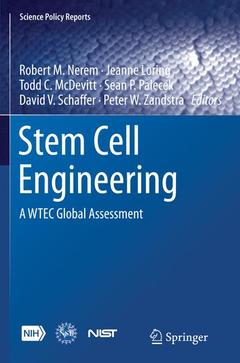Stem Cell Engineering, Softcover reprint of the original 1st ed. 2014 A WTEC Global Assessment Science Policy Reports Series
Coordonnateurs : Nerem Robert M., Loring Jeanne, McDevitt Todd C., Palecek Sean P., Schaffer David V., Zandstra Peter W.

This book describes a global assessment of stem cell engineering research, achieved through site visits by a panel of experts to leading institutes, followed by dedicated workshops. The assessment made clear that engineers and the engineering approach with its quantitative, system-based thinking can contribute much to the progress of stem cell research and development. The increased need for complex computational models and new, innovative technologies, such as high-throughput screening techniques, organ-on-a-chip models and in vitro tumor models require an increasing involvement of engineers and physical scientists. Additionally, this book will show that although the US is still in a leadership position in stem cell engineering, Asian countries such as Japan, China and Korea, as well as European countries like the UK, Germany, Sweden and the Netherlands are rapidly expanding their investments in the field. Strategic partnerships between countries could lead to major advances of the field and scalable expansion and differentiation of stem cells. This study was funded by the National Science Foundation (NSF), the National Institutes of Health (NIH) and the National Institute of Standards and Technology (NIST).
Preface.- Executive Summary .- Introduction.- Background .- Scope of the Study.- Prior Work at WTEC.- Panel Members.- Study Process.- Overview of the Report.- Translational Models.- Education.-Opportunities for Collaboration.- State of Stem Cell Engineering Outside of North America.- Conclusions.- Physical and Engineering Principles in Stem Cell Research.- Introduction.- Mechanoregulation of Stem Cell Function.- Topographical and Shape Features of the Stem Cell Niche.- Electric Fields.- Mass Transfer Influences on Stem Cell Behavior.- Development of Novel Technologies to Study Stem Cells.- Future Directions.- Global Assessment and Conclusions.- High-throughput Screening, Microfluidics, Biosensors, and Real-time Phenotyping.- Introduction.- High-throughput Screening of Factors Regulating Stem Cell Fates.- Global Assessment and Conclusions.- Computational Modeling and Stem Cell Engineering.- Introduction.- Current Trends in Computational Stem Cell Engineering.- Future Opportunities.- Global Assessment and Conclusions.- Stem Cell Bioprocessing and Biomanufacturing.- Introduction.- Stem Cell Bioprocessing Culture Technologies.- Automation Platforms for Stem Cell Culture And Preservation.- Future Directions.- Global Assessment and Conclusions.- Appendix A. Delegation Biographies.- Appendix B. Site Visit Reports.- Academy of Military Medical Sciences, Tissue Engineering Research Center.- Basel Stem Cell Network (BSCN), University Hospital Basel and University of Basel.- Berlin-Brandenburg Center for Regenerative Therapies.- Chinese University of Hong Kong (CUHK).- Fraunhofer Institute for Immunology and Cell Therapy.- Fudan University, Zhongsan Hospital.- Institute for Medical Informatics and Biometry (IMB), Dresden University of Technology (TUD).- Institute for Stem Cell Therapy and Exploration of Monogenic Diseases (I-STEM).- Institute of Biochemistry and Cell Biology, Shanghai Institutes for Biological Sciences.- Institute of Biophysics, Chinese Academy of Sciences.- Institute of Zoology, Chinese Academy of Sciences.- Karolinska Institute and Karolinska University Hospitals.- Keio University, Yagami Campus.- Kyoto University-CiRA (Center for iPS Cell Research and Application).- Laboratory of Stem Cell Bioengineering (LSCB), École Polytechnique Fédérale de Lausanne (EPFL).- Leiden University Medical Center.- Life&Brain Center, Bonn.- Lonza Cologne GmbH.- Lund University Biomedical Centre (BMC).- Max Planck Institute for Molecular Biomedicine.- National Natural Science Foundation of China (NSFC).- National Tissue Engineering Center, Shanghai Jiao Tong University School of Medicine.- Netherlands Initiative for Regenerative Medicine.- Okayama University, Graduate School of Medicine, Dentistry and Pharmaceutical Sciences.- Peking University, The College of Life Sciences.- RIKEN Institute, Kobe.- Shanghai Jiao Tong University, School of Medicine.- State Key Laboratory of Bioreactor Engineering.- Swiss Center for Regenerative Medicine (SCRM), University Hospital Zurich and University of Zurich.- Tokyo Women’s Medical University.- Tongji University School of Medicine.- Tsinghua University, School of Medicine.- University of Tokyo, Hongo Campus, Department of Biomedical Engineering.- University of Tokyo, Hongo Campus, Laboratory of Cell Growth and Differentiation.- University of Tokyo, Komaba Campus, Research Center for Advanced Science and Technology.- University of Tokyo, Komaba II Campus, Institute of Industrial Science.- University of Tokyo, Shirokanedai Campus.- Uppsala University.- Appendix C. “Virtual” Site Visit Reports.- Bioprocessing Technology Institute.- Conference for Stem Cell Engineering.- MEDIPOST, CO., Ltd. .- National University of Singapore (NUS).- Pharmicell Co., Ltd. .- Stem Cell Bioengineering Laboratory, Instituto Superior Técnico (IST).- Instituto de Engenharia Biomédica (INEB).- Royan Institute for Stem Cell Biology and Technology (RI-SCBT).- Stem Cells Australia.- Appendix D. Glossary of Abbreviations and Acronyms
Provides an overview of the worldwide status and trends in stem cell engineering
Describes how the US need to form strategic partnerships with other countries so as to leverage the existing and emerging strength outside of the US
Confirms the need for an increasing involvement of engineers in the field of stem cells and related technologies
Describes how computational models will be increasingly important to understand complex biological systems
Provides guidance to policy makers and funding agencies on future research directions and required investments
Includes supplementary material: sn.pub/extras
Date de parution : 08-2016
Ouvrage de 308 p.
15.5x23.5 cm
Disponible chez l'éditeur (délai d'approvisionnement : 15 jours).
Prix indicatif 105,49 €
Ajouter au panierDate de parution : 07-2014
Ouvrage de 308 p.
15.5x23.5 cm
Disponible chez l'éditeur (délai d'approvisionnement : 15 jours).
Prix indicatif 105,49 €
Ajouter au panierThèmes de Stem Cell Engineering :
Mots-clés :
Application of Microfluidics; Assessment of Stem Cell Engineering; Computational Stem Cell Engineering; High-Throughput Screening; In Vitro Models of Issues; Innovation in Stem Cell Engineering; Investment in Stem Cell Research; Organ-on-a-Chip; Regenerative Therapie; Scalable Expansion of Stem Cells; Stem Cell Biomanufacturing; Stem Cell Bioprocessing; WTEC Report on Stem Cell Engineering; World Technology Evaluation Center; biochemical engineering



